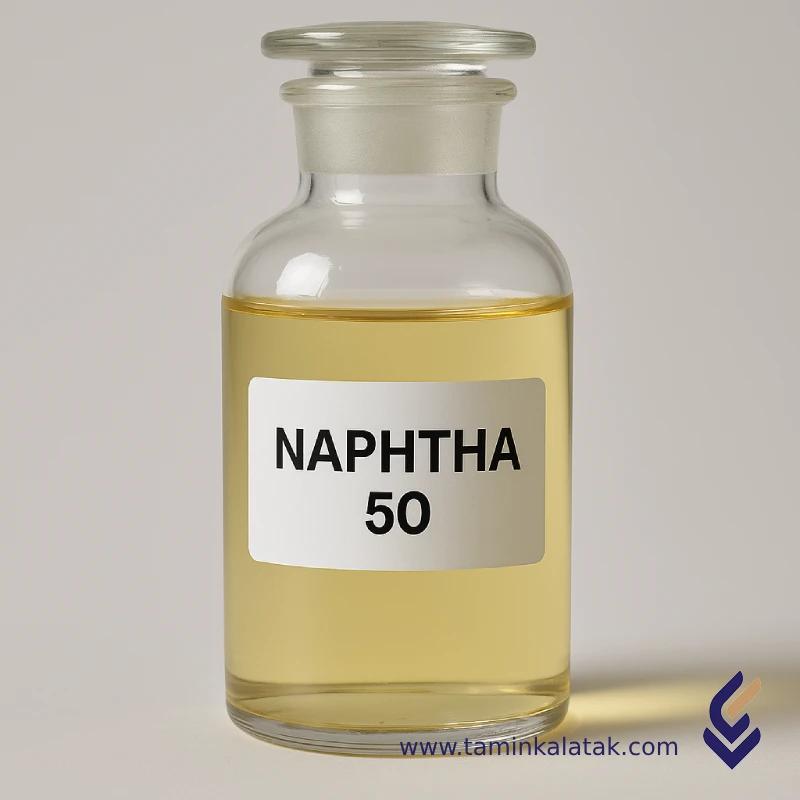Nafta 50
Naphtha 50 is a light petroleum fraction obtained either from the direct distillation of crude oil or through petroleum cracking processes. It is a mixture of aliphatic (paraffinic) and aromatic hydrocarbons containing carbon atoms ranging from C₅ to C₁₁.
Naphtha 50 is primarily used as a feedstock for petrochemical production, industrial fuels, and as a solvent in the chemical industry.
Chemical Structure and Composition of Naphtha 50
Naphtha 50 is a complex blend of various hydrocarbons, including:
-
Paraffins (C₅–C₁₁): ~50–60%
-
Cycloparaffins (Naphthenes): ~25–35%
-
Alkylbenzenes (Aromatics): ~10–15%
-
Dicycloparaffins and heavier components: ~1–3%
This composition gives Naphtha 50 diverse physical and chemical properties, making it highly valuable for multiple industrial applications.
Technical Properties of Naphtha 50
| Property | Specification |
|---|---|
| Boiling range | 30–200 °C |
| Density (g/cm³) | 0.70–0.75 |
| Water solubility | Insoluble |
| Color | Colorless to pale yellow |
| Flash point | Very low (below 30 °C) |
| Vapor characteristics | Heavier than air; capable of forming explosive mixtures with air |
| Odor | Hydrocarbon odor, similar to gasoline |
Applications of Naphtha 50
-
Steam Cracking Feedstock
Used to produce ethylene and propylene, key monomers for polyethylene, polypropylene, and other polymers. -
Aromatics Production (BTX)
For manufacturing benzene, toluene, and xylenes used in paints, resins, solvents, and plastics. -
Industrial Solvent
Applied in paints, varnishes, resins, and specialty cleaning agents. -
Fuel
Used in lighters, camping stoves, and blended fuels. -
Refinery Processes
Serves as a solvent for refining and separating petroleum fractions.
🌟 Advantages of Naphtha 50
✅ Versatile applications — used in petrochemical, refinery, fuel, and chemical industries.
✅ Wide availability — extensively produced in refineries.
✅ Cost-effective — cheaper than many other petrochemical feedstocks and solvents.
⚠️ Disadvantages of Naphtha 50
⚠️ Highly flammable — requires strict safety measures during transport, storage, and handling.
⚠️ Environmental impact — spills or evaporation can pollute soil, water, and air.
⚠️ Price volatility — directly influenced by global crude oil prices.
Safety and Storage of Naphtha 50
Main Hazards
-
Highly flammable liquid and vapor
-
Explosion risk in enclosed spaces
-
Causes skin, eye, and respiratory irritation upon contact or inhalation
-
Chronic exposure may damage the nervous system and liver
Safety Precautions
-
Store in approved containers designed for flammable fuels
-
Keep away from heat, sparks, flames, and ignition sources
-
Ensure proper ventilation in enclosed areas
-
Use personal protective equipment (PPE): resistant gloves, safety goggles, and filter masks
-
Always follow MSDS (Material Safety Data Sheet) guidelines
Applications
| Applications | , , , , , |
|---|
Nafta 50
| Solubility in water | Melting point | Density (at 20°C) | Physical appearance | Vapor pressure | Grid | شماره CAS | Chemical formula | Chemical name |
|---|---|---|---|---|---|---|---|---|
| Insoluble (less than 0.01 g/L) | Below -30 °C (approx.; depending on composition) | 0.70 – 0.75 g/cm³ | Clear, colorless to pale yellow liquid | About 1.5 – 2.0 kPa | Industrial grade – solvent and petrochemical feed | 64742-49-0 (برای Naphtha (petroleum), hydrotreated light) – | C₅–C₁₁ hydrocarbon mixture (does not have an exact formula because it is a mixture) | Naphtha (Petroleum), Light Aliphatic / Aromatic |







